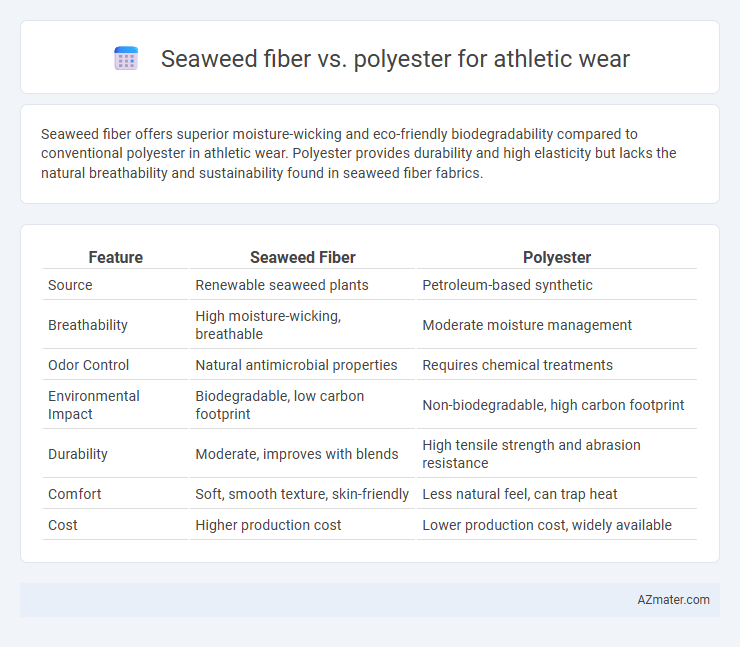Seaweed fiber offers superior moisture-wicking and eco-friendly biodegradability compared to conventional polyester in athletic wear. Polyester provides durability and high elasticity but lacks the natural breathability and sustainability found in seaweed fiber fabrics.
Table of Comparison
| Feature | Seaweed Fiber | Polyester |
|---|---|---|
| Source | Renewable seaweed plants | Petroleum-based synthetic |
| Breathability | High moisture-wicking, breathable | Moderate moisture management |
| Odor Control | Natural antimicrobial properties | Requires chemical treatments |
| Environmental Impact | Biodegradable, low carbon footprint | Non-biodegradable, high carbon footprint |
| Durability | Moderate, improves with blends | High tensile strength and abrasion resistance |
| Comfort | Soft, smooth texture, skin-friendly | Less natural feel, can trap heat |
| Cost | Higher production cost | Lower production cost, widely available |
Introduction to Seaweed Fiber and Polyester in Athletic Wear
Seaweed fiber, derived from sustainably harvested algae, offers natural breathability, moisture-wicking properties, and biodegradability, making it an innovative choice for eco-conscious athletic wear. Polyester, a synthetic fiber made from petroleum-based polymers, is widely favored in athletic apparel for its durability, moisture management, and quick-drying capabilities. Comparing these materials highlights sustainability advantages of seaweed fiber against polyester's performance longevity within activewear applications.
Material Origins: Natural vs Synthetic Fibers
Seaweed fiber, derived from sustainable algae sources, offers biodegradable and eco-friendly properties ideal for athletic wear, promoting moisture-wicking and breathability through natural fiber structures. Polyester, a synthetic polymer produced from petrochemicals, provides durability, stretch, and quick-drying capabilities but relies on non-renewable resources and contributes to microplastic pollution. The contrast between seaweed fiber's renewable, biodegradable origin and polyester's synthetic, oil-based composition highlights the environmental trade-offs in athletic fabric choices.
Breathability and Moisture Management
Seaweed fiber in athletic wear offers superior breathability compared to polyester, allowing better air circulation and reducing heat buildup during intense workouts. Its natural moisture-wicking properties absorb sweat efficiently while maintaining a dry feel, enhancing comfort for athletes. In contrast, polyester tends to trap heat and moisture, leading to less effective moisture management and potential skin irritation.
Comfort and Skin Sensitivity
Seaweed fiber in athletic wear offers superior moisture-wicking and breathability compared to polyester, enhancing comfort during intense workouts. Its natural anti-bacterial and hypoallergenic properties reduce skin irritation and sensitivity, making it ideal for users with sensitive skin. Polyester, while durable and quick-drying, often traps heat and may cause discomfort or allergic reactions in prolonged wear.
Durability and Longevity
Seaweed fiber offers moderate durability but tends to degrade faster under intense physical activity and frequent washing compared to polyester, which is renowned for its exceptional strength and resistance to abrasion. Polyester's long lifespan and ability to maintain shape and color make it a preferred choice for athletic wear subjected to rigorous use. Seaweed fiber's eco-friendly properties come with a trade-off in longevity, whereas polyester ensures sustained performance over time.
Environmental Impact and Sustainability
Seaweed fiber offers superior environmental benefits compared to polyester, as it is biodegradable and derived from renewable marine resources without relying on fossil fuels. Polyester production typically involves significant carbon emissions and contributes to microplastic pollution in oceans, posing challenges for sustainability in athletic wear. Choosing seaweed fiber reduces ecological footprints by minimizing energy consumption and promoting circular economy practices in sports apparel manufacturing.
Performance in Athletic Activities
Seaweed fiber offers superior moisture-wicking and breathability compared to polyester, enhancing comfort and reducing skin irritation during intense athletic activities. Polyester provides excellent durability and quick-drying properties, making it suitable for high-impact sports requiring robust fabric performance. The natural antifungal and antibacterial qualities of seaweed fiber contribute to odor control, giving it an edge in maintaining freshness during extended wear.
Odor Resistance and Hygiene
Seaweed fiber exhibits superior odor resistance compared to polyester due to its natural antimicrobial properties, which inhibit bacterial growth that causes unpleasant smells during intense workouts. Polyester tends to retain odors as it is prone to bacterial buildup, requiring frequent washing to maintain hygiene. Seaweed fiber also offers enhanced breathability and moisture-wicking capabilities, promoting a fresher and more hygienic athletic wear experience.
Care and Maintenance Requirements
Seaweed fiber athletic wear requires gentle washing in cold water and air drying to preserve its natural properties and prevent fiber degradation, while polyester garments tolerate machine washing and drying with minimal risk of damage. Seaweed fibers are biodegradable, making eco-friendly laundry detergents preferable to avoid environmental harm, whereas polyester's synthetic nature demands low-maintenance care but contributes to microplastic pollution during washing. Proper care of seaweed fiber prolongs its durability and comfort, whereas polyester's resilience allows for frequent washing without significant wear.
Cost and Market Availability
Seaweed fiber athletic wear is generally more expensive due to its sustainable production process and limited market availability compared to polyester, which is widely produced and cost-effective. Polyester dominates the athletic wear market because of its affordability, durability, and mass production capabilities. The growing demand for eco-friendly materials like seaweed fiber is gradually increasing availability but has yet to match the scale and price competitiveness of polyester.

Infographic: Seaweed fiber vs Polyester for Athletic wear
 azmater.com
azmater.com